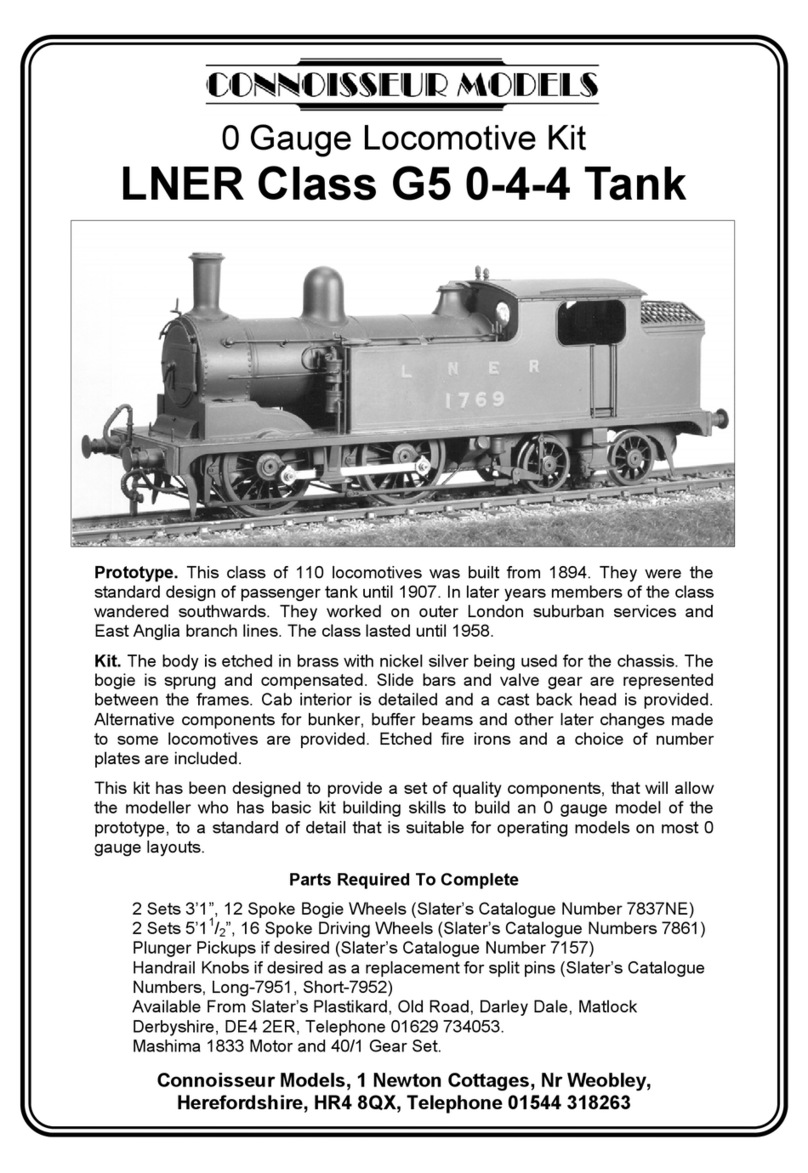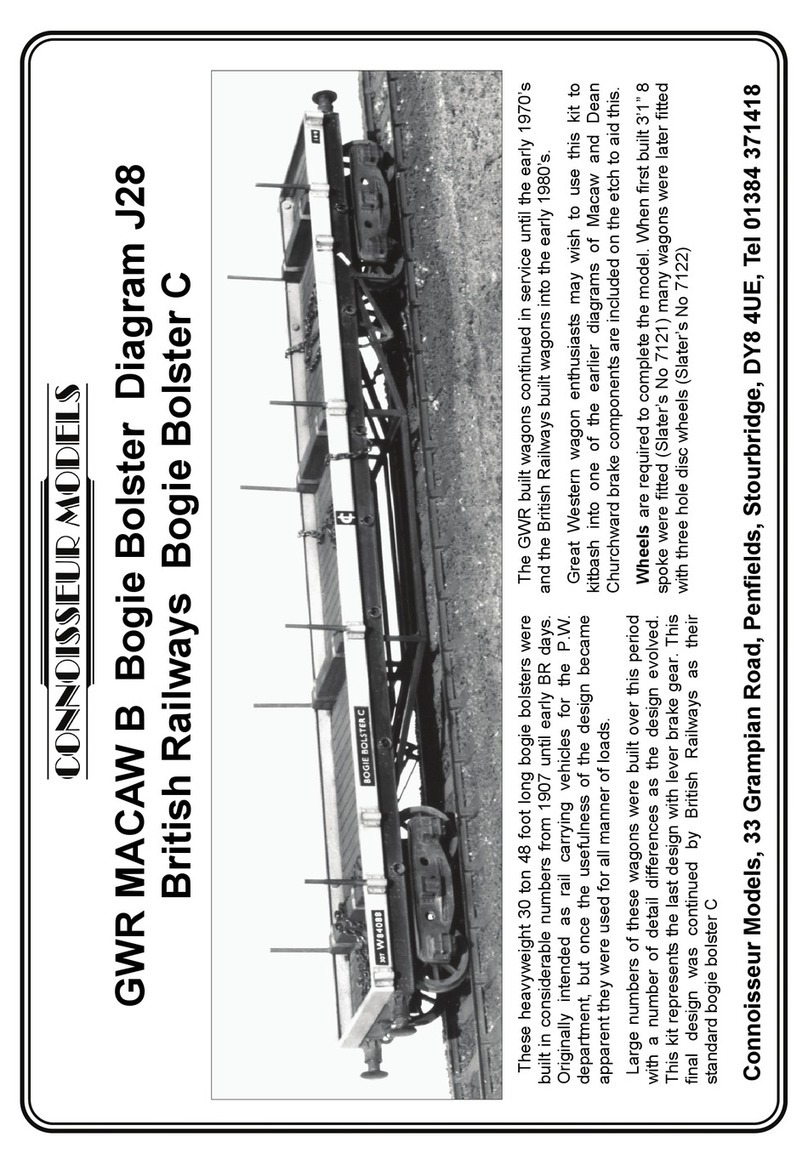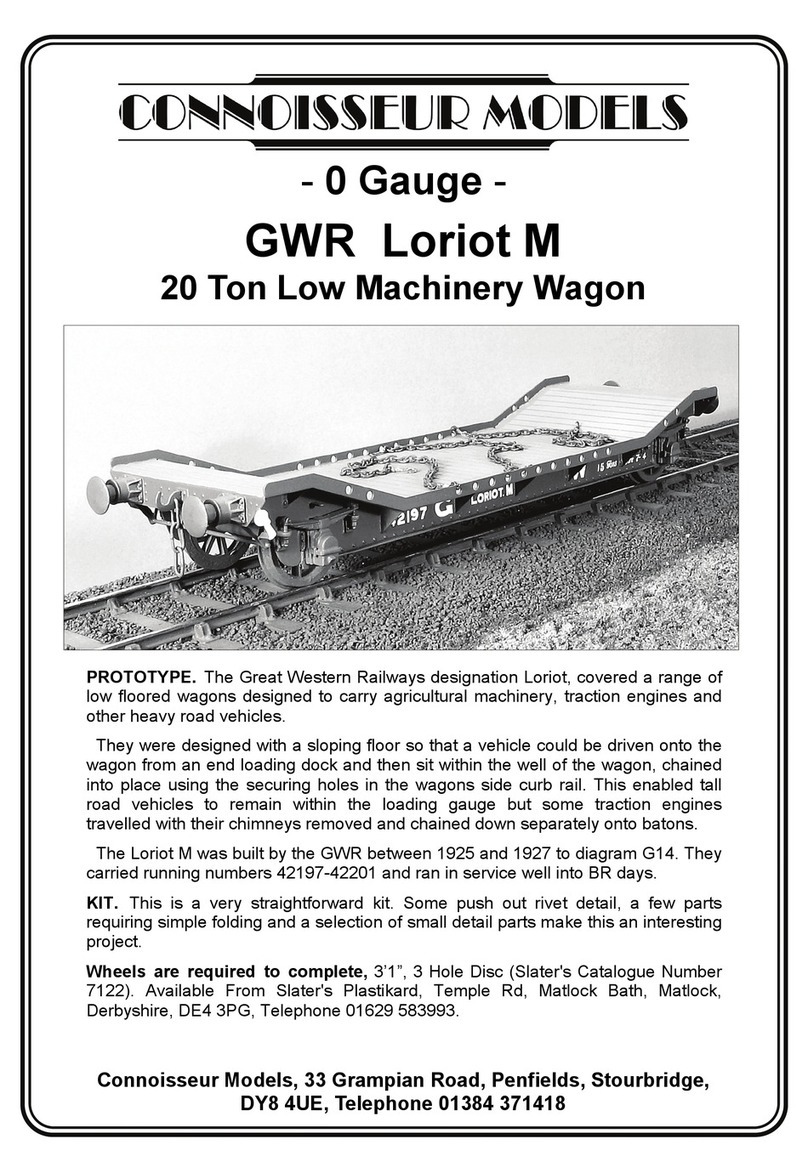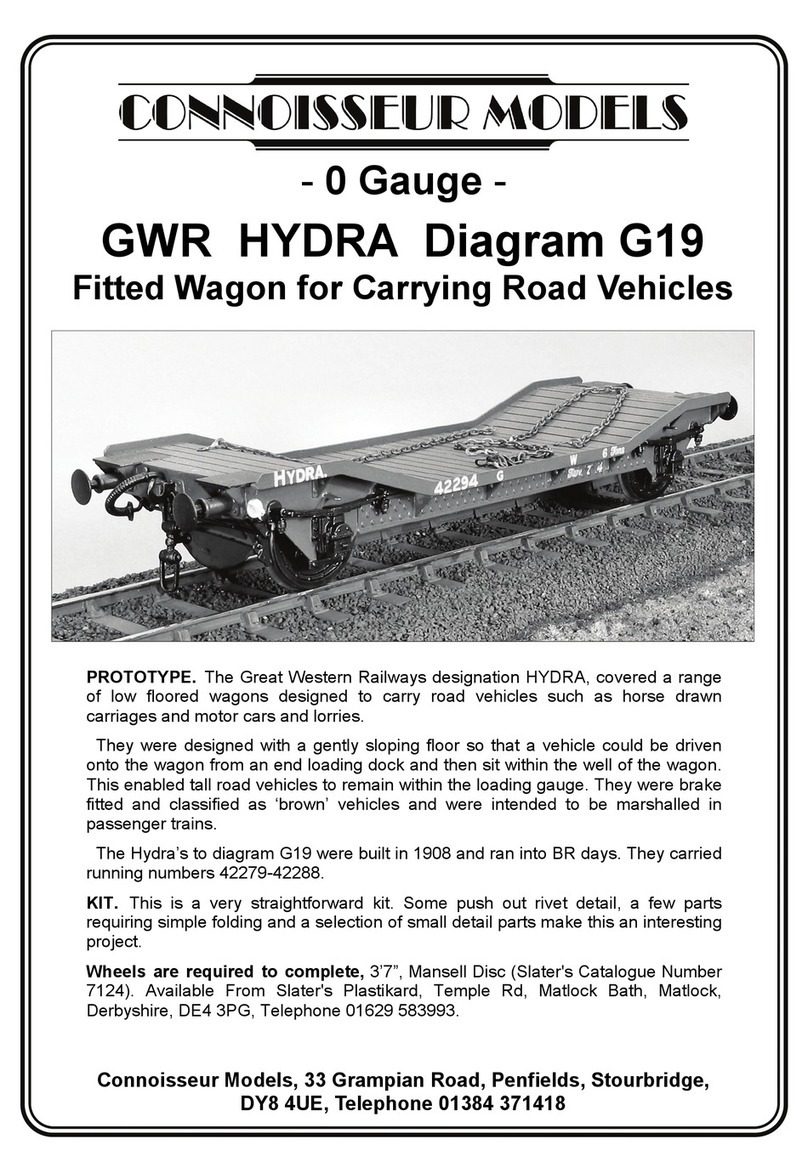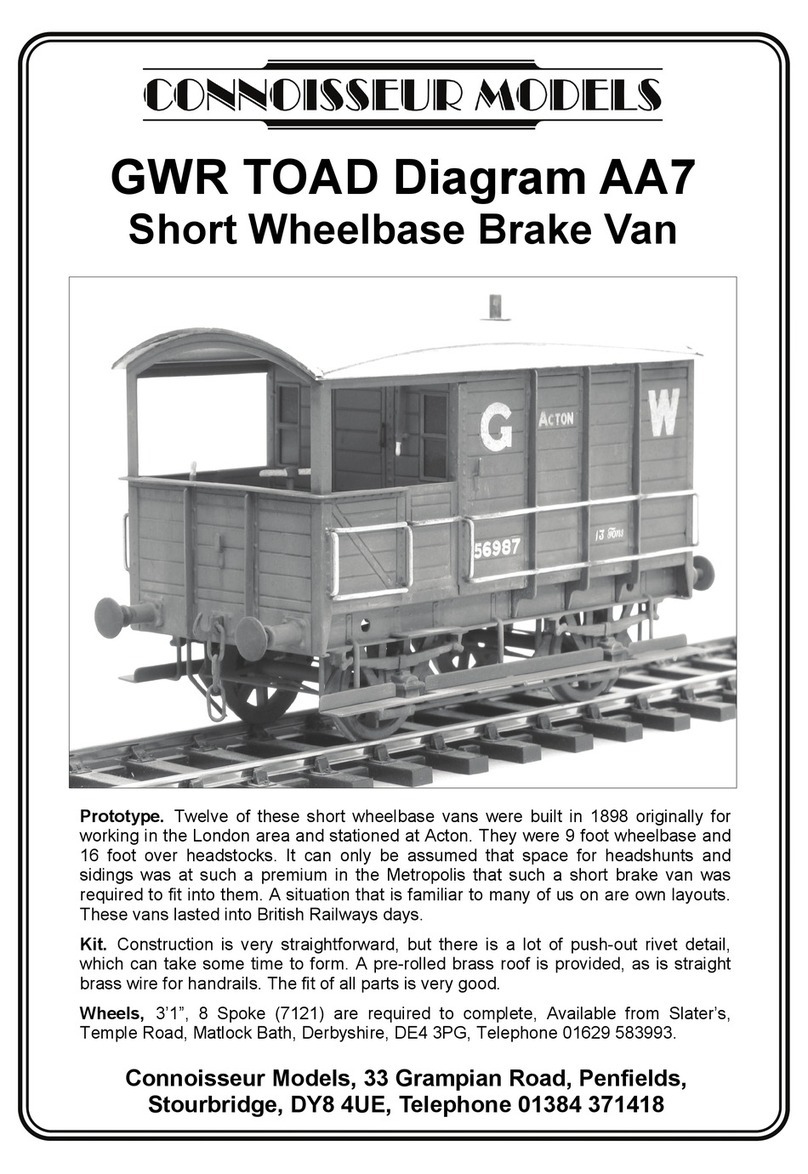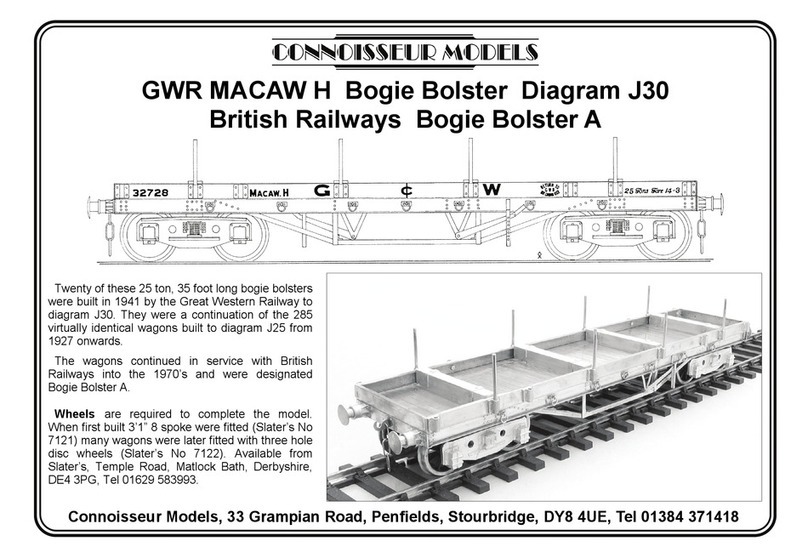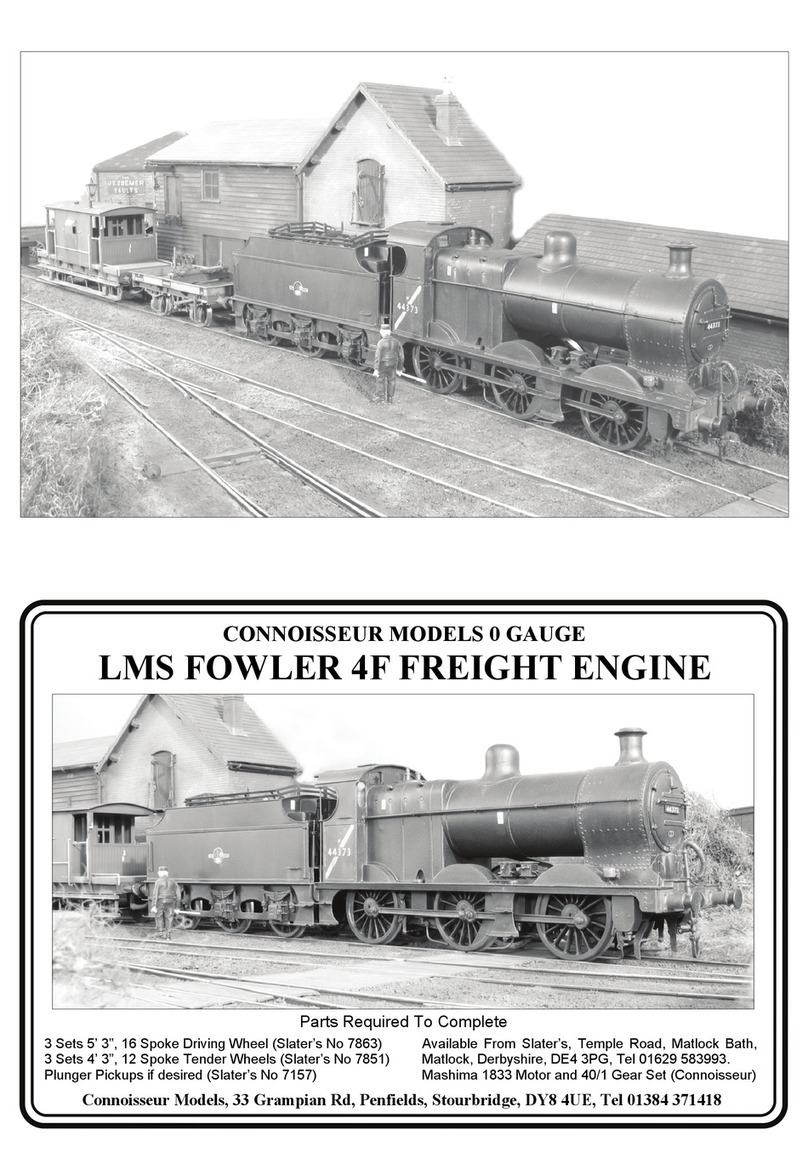Three-dimensional parts are formed by folding. On an etched brass kit the fold
lines are normally half-etched on the inside of the fold. You’ll be able to fold most
parts using smooth-jawed pliers. For longer parts folding bars are desirable.
Other useful tools include a bench vice, a good pair of tweezers, a set of Swiss
files (get a full set of cheap ones and then buy quality replacements for the three
that you use the most), a pin vice with a selection of drills from 0.5mm to 2.1mm
plus a few larger sizes that you use regularly (2.6mm for axle bearings etc), some
square-nosed pliers and some very pointed-nosed ones, preferably with smooth
jaws. Buy cheap tools first and duplicate the most used ones with quality.
Try to complete all high-temperature soldering before attaching any of the cast
whitemetal parts. These can be attached with two-part epoxy resin such as Araldite
Rapid. Ensure the surfaces to be glued are clean and free of grease.
A better alternative is to solder your white metal castings using Carrs 70 degree
low melt solder and Carrs red label white metal flux. The iron should be run at a
much lower heat so that you do not melt the castings. I have a domestic light
dimmer switch and plug socket fixed to a piece of wood, wired up with a lead and
standard mains plug fused at 3 amps to the input side of the dimmer switch and the
output of the dimmer switch into the plug socket (remember to continue the earth).
Plug your 40 Watt iron (25 Watt iron won’t work) with a clean and freshly tinned bit
into this and experiment with adjusting the switch until you find the range of
temperature at which the solder melts but a scrap casting does not. Note as the
iron is running at a lower voltage it will take longer to heat up, so when you think
the adjustment is correct do check a few minutes later on another scrap casting to
see that it doesn't melt. Then scribe a mark on the switch knob to indicate this
position.
When attaching white metal fittings to brass the surface of the brass must be
tinned with 145° solder to allow the solder to grip. The surface of the casting at the
joint should be burnished bright. The casting can then be soldered into place with
70° solder and fillets of solder run into any gaps with no risk of melting the casting.
Virtually all castings will be improved by a little extra fettling work. Flash can be
cleaned out using a sharp pointed knife blade, part lines removed by scraping back
with a curved blade and then blending in using a fibreglass brush. The casting
moulds tend to distort when metal flows in so check castings for square and even
thickness.
SPECIFIC INSTRUCTIONS FOR LOCOMOTIVE KITS
Hole Sizes. Because of the etching process holes will normally be found
undersize, for example the turned brass bearings will not fit holes in chassis sides,
and a simple fitting operation is required. The best tool for opening up holes of this
size is a cheap tapered reamer available at most model railway shows from tool
suppliers. By rotating this gently in the hole you quickly open holes to correct size
without risk of tearing the metal. By trial and error on the first hole you will soon
establish how much material requires removal. For smaller holes, such as those for
the location of casting's etc, are best opened up using a set of cheap tapered
broaches, or by twisting a small round file in the hole.
Page 4
22. Painting is a vast subject that cannot be coveredfully here. The important thing
with a metal model is to get a good base coat of primer. Hopefully you have been
cleaning up and washing the model at the end of each modelling session but it will
still need thoroughly cleaning before painting. I give my models a good scrub with a
stiff-bristled paint brush in a sink full of hot water, as hot as your hands can bear,
and cheap washing up liquid (the expensive stuff that’s kind to your hands has an
oil in it that will stop the paint keying to the metal). If you know somebody who
works in catering and can scrounge you some industrial-strength liquid this is better
still. Then rinse the model a couple of times in clean warm water and place in a
dust-free box to dry.
I use car aerosol primer and Halfords grey primer is one of the best. For the best
results you want to spray at room temperature (25°C) on a dry day, avoid cold,
damp or humid days. I find it helps to warm the model to about 30°C (put it in the
airing cupboard overnight) and I warm up the paint tin by putting it onto a radiator
(about 40°C, but use your common sense as I don’t want anybody blowing
themselves up). I find it best to prime the model in two light coats, about 15 minutes
apart and then leave for 48 hours to harden off (in the airing cupboard in a dust-free
box).
I brush-paint my models with Humbrol enamel. For years I just stirred it up and
painted straight from the tin but I was never completely happy with the results.
Recently two things have transformed my painting. The first was a copy of Martyn
Welch’s book, The Art of Weathering, Wild Swan Publications, ISBN 1 874103 11
9. Martyn’s basic techniques are very useful and almost foolproof. The second
thing is to mix the paint in the tin and then transfer it to a palette (a sheet of clean
plasticard) with blobs of lighter and darker shades of paint surrounding the main
colour. Then work the paint with the brush on the palette, slightly varying the tones
of the paint. This seems to totally change the texture of the paint and the way it
goes on and covers on the model.
There is much debate about what are the precise livery details for any historical
loco at any time so I have assumed that if you are an established NER modeller
you will have your own reference library. If you are a general modeller who wants
general guidance then I don't think we can do better than look at how the preserved
locos are painted today and copy them. Try a google images search, “LNER Class
Y7”, then look for images on flicker, you will find plenty of colour pictures.
The standard NER livery for tank locos until 1904 was black for top surfaces of
footplate, steps, tank tops etc & smokebox. Boiler, tank sides, cab etc, Saxony
green with black edges lined white. Tank sides, ends and bunkers were panelled by
a 2” black band with a 3/16“ white line on each side. Buffer beams vermilion with
buffers and beams edged black and lined white. Cab roof colour is a bit unsure but
was probably grey when first painted but was very soon dirty black. Cab interior
cream with dirty wood floor.
From 1904 the NER changed tank loco livery to overall black with fine red lining
and lettered NER but locos would only be repainted when they entered works for
general repair.
Page 33
